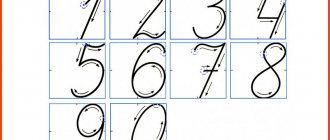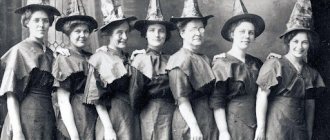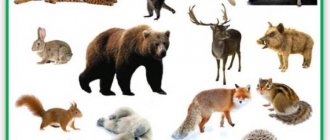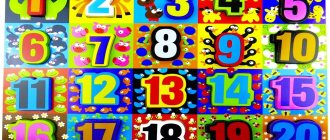Target. Introduce children to the formation of the number 9 and practice counting within 9; show the independence of the number of objects from the area they occupy; consolidate the ability to establish relationships between objects in height and thickness, organize the placement of objects according to one of the dimensions, distracting from others. Show that the place occupied by an object among others changes depending on what characteristics of the object are compared.
Demonstration material: typesetting canvas, color images of 9 daisies and 9 marigolds; 4 cylinders of different thickness and height. The height of the cylinders gradually decreases from 25 to 10 cm, and the diameter of the base increases from 6 to 15 cm.
Handout: cards with 2 free stripes, on the tables - trays with pebbles and chestnuts (10 items for each).
Progress of the lesson.
Part 1. On the typesetting canvas, images are placed in 2 horizontal rows: 7 daisies and 8 marigolds! Chamomiles are placed at greater intervals than marigolds! Children count and find out that there are fewer daisies than marigolds, since 7 < 8, and 8 > 7. The teacher asks how this can be checked. Calls the child, invites him to place the marigolds under the daisies and give an appropriate explanation. The numbers of different flowers are equalized, there are 8 of them. The teacher demonstrates how to form the number 9.
Physical education moment. Children must show 3, 5, 7, 9 fingers!
Part 2 (work with handouts). Children are asked to put 8 chestnuts on the top strip of the card, and 9 pebbles on the bottom strip. When they complete the task, one child is asked to count the chestnuts out loud (loudly), and the other to count the pebbles. The rest of the children simultaneously (together) count their objects to themselves; They ask questions: “More (less) chestnuts or pebbles. How many are there? Which number is greater (smaller): 8 or 9? What needs to be done so that there are equal numbers of items – 8, 9?” Children equalize the aggregates, choosing the method of their choice, and tell what they did, how many objects they have.
3rd part. The teacher places 4 cylinders of different sizes mixed on the table and asks the children what can be said about the size of the cylinders. - Are they the same height? thickness? One child shows the tallest and lowest cylinder, another shows the thickest and thinnest, the third arranges the cylinders in a row from highest to lowest and names the height of the cylinders in order (“lower”, “even lower”). Next, the teacher mixes the cylinders and invites one of the children to put them in a row from thickest to thinnest. The cylinders are deployed with the bases facing the children. The child describes the order in which the cylinders are now arranged. The teacher places the cylinders without changing their places and asks the children where the highest (lowest) is now and why.
Note. In the next lesson, the teacher sets the goal of strengthening in children the idea of the formation of the number 9 and the skills of counting objects within 9, learning to compare and order objects by length and thickness, and ordering objects according to one of the dimensions, distracting from other dimensions.
MAGAZINE Preschooler.RF
Author: Natalya Vasilievna Varushkina, teacher of MAOU Secondary School 5, Kindergarten No. 41, Krasnokamsk Description of the material: I offer you a summary of direct educational activities for children of the older group (5-6 years old) on the topic “Alice is learning to count.” This material will be useful to teachers of the senior group. Summary of the direct educational activities of children in the senior group on the topic: “Alice learns to count.” Types of children's activities: playful, productive, communicative, cognitive and research. Goals: to continue to develop in children the ability to count ordinal within 10. Objectives: Educational: to form elementary ideas about the composition of the number 9, to perform mathematical operations. Ability to work collaboratively. Developmental: develop attention, memory, logical thinking. Educational: to cultivate interest in natural sciences. Demonstration materials: doll, 9 plastic cups, 9 plates, cards with dots. Counting sticks. Methodical techniques: game situation. Conversation is a dialogue, an active game, a productive activity for children. Progress of GCD: Educator: Guys, our universally favorite doll Alice came to us, as always, with her mathematical problem. Alice is expecting guests today, there will be 8 of them. How many cups do we need to supply so that there is enough for everyone? (Answer) 8 - Alice will also drink tea, which means we need to add another glass for the hostess. What mathematical symbol should I write to make an example? Children's answer: 8 + 1 =9 Educator: let's count how many cups we have in total? - children count in chorus and individually. The teacher puts one plate and places it near the glass. — Guys, what do I need to do so that there are enough plates for everyone? Answer: you need to add 8 more plates. Game: “Show as many” Children place on the table the same number of counting sticks as the teacher shows in the picture. The number of points must be from 1 to 9. Outdoor game “Owl” Consolidating the skill of orientation on a sheet of paper. — While playing with the mirror, Alice loved to make sunbeams. And I even came up with a poem about how the sunbeam jumped. I will read a poem, and you draw a bunny (In the form of a circle) In a square clearing, A sunny animal was running, He ran, jumped and climbed into the upper right corner, He lay there for a while, He ran away to the upper left. The bunny gnawed an aspen tree there, Jumped straight into the middle, The little bunny jumped, the gray one jumped, And he climbed into the lower left one, The bunny jumped and got tired, He ran away into the lower right one. Reflection: - What problem did the Alice doll give us? - How many glasses and plates did we count? — What game did you play? - What else did we do?| Next > |
Summary of a lesson on FEMP in the senior group on the topic “Introduction to the ordinal value of numbers 8 and 9”
FEMP senior group on the topic “Introduction to the ordinal value of the numbers 8 and 9”
Lesson form: Group (subgroup) Age group: 5-6 years Duration of the lesson: 25 minutes Purpose: to introduce the number 9 Objectives: - to introduce the ordinal value of the numbers 8 and 9, learn to correctly answer the questions “How much?”, “Which one?”, “Which place?”; - exercise the ability to compare objects by size, designate the results of comparison with words: largest, smaller, even smaller (and vice versa); - exercise the ability to find differences in images of objects; - develop thinking, creative imagination, memory, speech, the ability to listen to the answers of comrades; - cultivate concentration, goodwill, mutual assistance. accuracy - to evoke an emotionally positive attitude towards the upcoming Mother's Day holiday. Preliminary work. cognitive development, physical development, speech development, artistic and aesthetic development. Visual aids: verbal, visual.
Berries 9 pcs, basket, bouquet consisting of flowers of various sizes. Progress of the lesson
Educator: Guys, look who came to visit us? Children: this is Kitty Educator: Hello, Kotofey! Kotofey: Hello, guys! Kotofey: Guys, tell me, can you count? Children: children's answers Kotofey: Let's count the gifts in my basket. Children: answers Kotofey takes out the berries and examines them. Oh guys, I forgot the numbers. Help me out. Help! Children: 1-9 Kotofey: how many berries are there? Children: 9 Kotofey: Tell me guys: was this a serial count or a reverse count? (CHILDREN'S ANSWERS) Kotofey: let me add up my gifts and you and I will count...What was the name for counting in the opposite direction? Children: 9-1 Kotofey: Guys, this is not all that I brought you. Look what flowers? Children: (children's answers) Kotofey: yes, I have flowers: big, small and even smaller flowers. Kotofey: I invite YOU to play with me: the game is called “Magic Flower”. Now I’ll choose a boy and a girl and see who can collect the magic flower faster. Well done! I offer you a warm-up! Physical education lesson “Hurray!” One, two, three, four (Arms to the sides and with force to the shoulders) We will be the strongest in the world. We will protect the world, (Raise straight arms and cross over head) We will hug mom. Let's stand on our toes, (Rise on our toes) Let's get the sun. We count to nine! Final stage: Analysis. Reflection. Educator: Guys, tell me: - What new did you learn in today's lesson? - What did you like? —What can you tell us about at home? Kotofey: Well done, guys! Goodbye!!!
We recommend watching:
Summary of a lesson on the development of elementary mathematical concepts in the senior group. Summary of entertainment in mathematics for kindergarten. Senior - preparatory group Summary of a mathematics lesson in the senior group on the topic: Winter Methodological manual on REMP for children of senior preschool age
Similar articles:
Summary of an integrated lesson in the senior group of kindergarten on the topic: Riddles
Abstract of GCD in mathematics in kindergarten in the senior group on the topic “Vertex, angle, side of a geometric figure”
Summary of a lesson on FEMP in the senior group of a preschool educational institution. Topic: “Composition of a number of units (number 7)”
Lesson notes on FEMP in the senior group. Count within 7
Math lesson notes “Number 6”. Senior group






